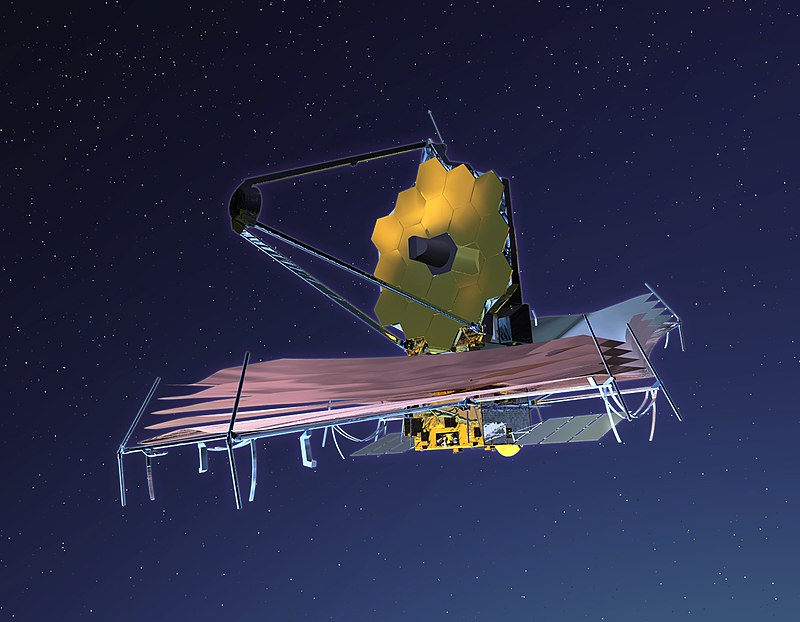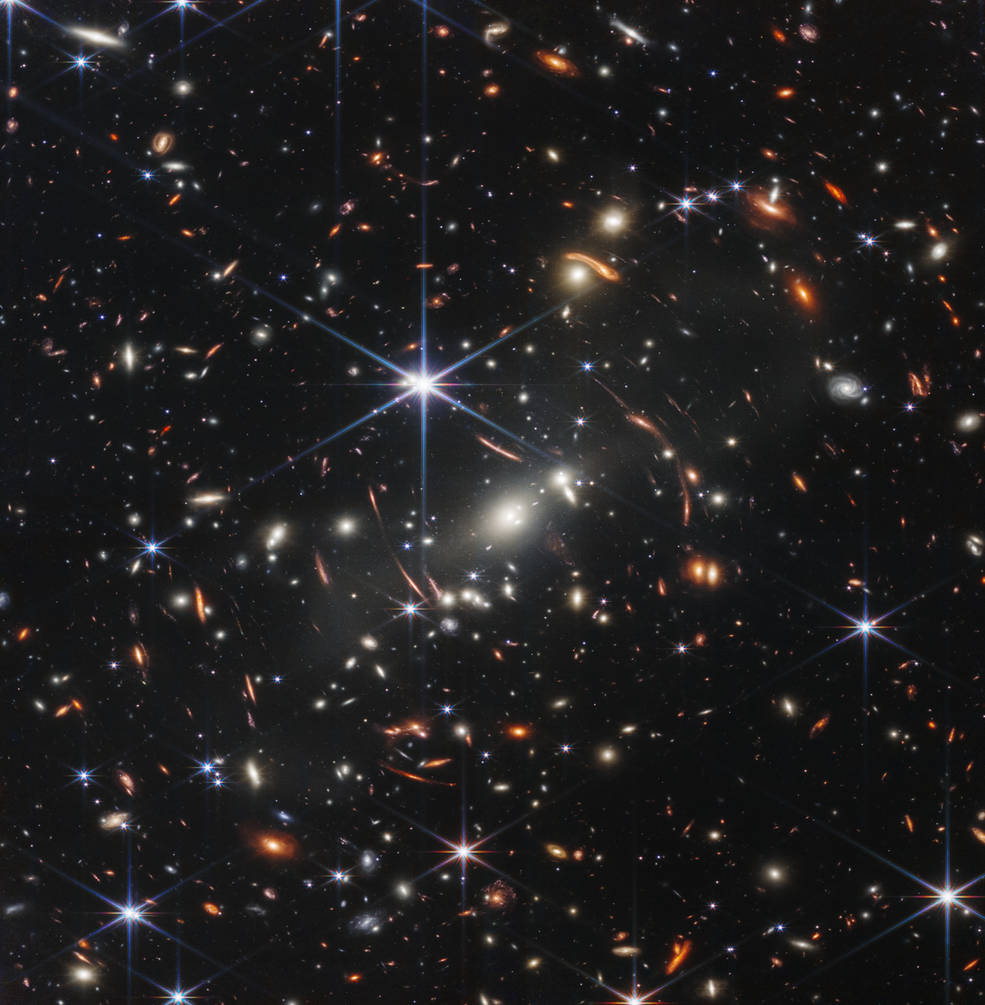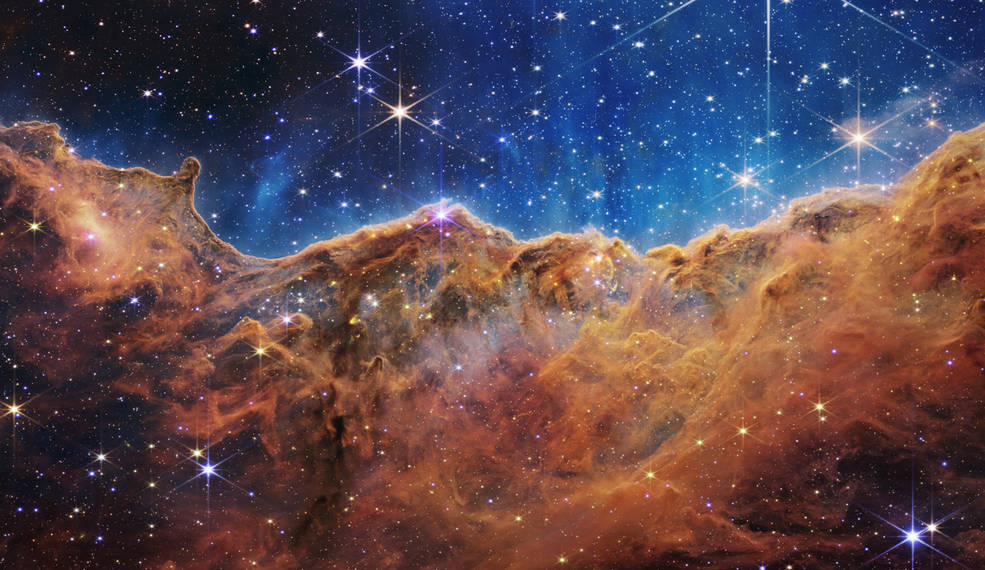 Today's date of Tuesday, July 12, 2022, is destined to remain for a long time in the memory of scientists as one of the great dates in astrophysics. The first color images and spectroscopic data collected in previous weeks by the James Webb Space Telescope (JWST), the new space telescope launched last Dec. 25, 2021, have been released today by NASA, ESA and CSA, respectively the U.S., European and Canadian space agencies. As a preview, a few hours before the official announcements, the galaxy cluster SMACS 0723 in the constellation of the "Flying Fish", located along the direction of the star HD 147980, had already been shown. This is the highest resolution infrared image ever obtained, taking the observer to about 13 billion years ago, only a few hundred million years after the beginning of the expansion of the universe, known to all as the Big Bang. This slice of the vast universe contains thousands of galaxies and covers a patch of sky approximately the size of a grain of sand held at arm’s length by someone on the ground. Both this image and those of the other 4 celestial objects employed as targets and released a few hours ago are truly extraordinary. In addition to the galaxy cluster SMACS 0723, photographs were released of the NGC 3324 nebula in the Carina constellation, and the planetary nebula NGC 3132, relatively nearby objects with vivid color patterns; the "Stefan Quintet," a group of interacting galaxies well known to astronomers since a few generations; and the spectrum of the extrasolar planet Wasp-96.
Today's date of Tuesday, July 12, 2022, is destined to remain for a long time in the memory of scientists as one of the great dates in astrophysics. The first color images and spectroscopic data collected in previous weeks by the James Webb Space Telescope (JWST), the new space telescope launched last Dec. 25, 2021, have been released today by NASA, ESA and CSA, respectively the U.S., European and Canadian space agencies. As a preview, a few hours before the official announcements, the galaxy cluster SMACS 0723 in the constellation of the "Flying Fish", located along the direction of the star HD 147980, had already been shown. This is the highest resolution infrared image ever obtained, taking the observer to about 13 billion years ago, only a few hundred million years after the beginning of the expansion of the universe, known to all as the Big Bang. This slice of the vast universe contains thousands of galaxies and covers a patch of sky approximately the size of a grain of sand held at arm’s length by someone on the ground. Both this image and those of the other 4 celestial objects employed as targets and released a few hours ago are truly extraordinary. In addition to the galaxy cluster SMACS 0723, photographs were released of the NGC 3324 nebula in the Carina constellation, and the planetary nebula NGC 3132, relatively nearby objects with vivid color patterns; the "Stefan Quintet," a group of interacting galaxies well known to astronomers since a few generations; and the spectrum of the extrasolar planet Wasp-96.
Web sites can be easily found where detailed information about the instruments aboard the James Webb Space Telescope (JWST) and the early results just coming from this extraordinary telescope are accessible to all (we summarize some of them at the end of this page). Anyone will be able to access them with little effort. As was the case with the Hubble Telescope (HST), there will be many spin-offs from the Webb Telescope's observations in the mass-media and cultural levels, in addition to those proper to the scientific level. Actually, there are three considerations that catch my attention now and that I would like to share with you.

Credits NASA, ESA, CSA, STScI
The first of these is the great interest with which virtually all media outlets have been following JWST's work in recent hours, offering very significant headlines. Almost all of them speak with excitement about the possibility of observing the most distant objects ever seen so far, shortly after the Big Bang, around the time when matter, decoupled from radiation, began to organize itself into macrostructures that would give rise to the first clusters of galaxies. It is a "looking toward the origins," many point out. Spectroscopes aboard JWST will also be able to examine a good number of atmospheres of extrasolar planets, helping us to understand what percentage of them possess Earth-like conditions, still pointing toward another question about origins, the origin of life in the cosmos. Questions that continue to attract and explain why the general public is following and will follow in the next months JWST's activities with interest. They are questions of philosophical, and to some extent even religious, scope, that are raised by the sciences today. They will never lose relevance. If philosophers or theologians no longer talk about them, it will be scientists, as is already the case, who will keep them alive.
A second consideration concerns the ability with which we human beings, in a bit more than three centuries since the introduction of the scientific method, have been able to formulate theories capable of describing the dynamics of the universe on a large scale, considering the whole cosmos as a single object of intelligibility. Only 250 years after Joseph-Louis de Lagrange solved the simplified three-body problem by showing the dynamic equilibrium of the so-called "five Lagrangian points," we can now place a telescope more than 6 meters in diameter at the L2 point of the system consisting of the earth, the moon and JWST itself. A few decades after Albert Einstein formulated the theory of General Relativity, we have repeatedly been able to verify its correctness, as the image of the SMACS 0723 cluster of galaxies photographed by JWST today does, by showing us the deflected images of the light rays of very distant galaxies, curved by the gravitational field of the massive galaxies at the center of the cluster.
A third consideration, finally, concerns the extreme level of precision achieved by the instruments aboard the JWST and the electromechanical structures that enable these instruments to operate. We have seen the 18 gold-plated hexagonal beryllium elements unfold to make up the grandiose mirror more than 6 meters in diameter, and precisely positioning themselves one and a half million kilometers from Earth. Heat shield technology allows the instruments to work at very low temperature despite exposure to solar radiation. The MIRI (Mid InfraRed Instrumentum) operates at a temperature of only 6 degrees above 0° Kelvin, provided by a mechanical helium chiller. The individual hexagonal dowels are independently adjusted by adaptive optics techniques that continuously correct the precision of the pointed image. Although we are accustomed to great accuracies in scientific activities on earth, such as sophisticated surgical operations or the performance of large particle accelerator detectors, now generating this precision millions of kilometers from earth, with remote controls, is something that never ceases to amaze.

Credits NASA, ESA, CSA, STScI
The images from the James Webb Space Telescope tell us not only about cosmic objects: they also tell us about ourselves. They tell us who we are. We are a biological species that in a few hundred thousand years has gone from solving primary survival problems to asking philosophical questions about its origin and destiny. In just over 300 years we have gone from writing the first differential equations to understanding how to theoretically represent the universe in which we live. In less than 200 years we have gone from discovering the equations of electromagnetism to operating sophisticated measuring instruments millions of miles from our planet. This is Homo Sapiens. And that tells us a lot about his uniqueness, about the mystery that he is in himself, in this universe in which he dwells. I am a Catholic priest. Today, in the celebration of Holy Mass, I ideally placed on the altar, along with the bread and wine, “fruit of the earth and work of human hands,” the extraordinary work that enables JWST to function and send us its wonderful results. Work of men and women who testify to the greatness of human intelligence, but also —I gladly add together with all believers in God— to the greatness of the Creator whose image we are.
Giuseppe Tanzella-Nitti
Director - DISF Cente
The first 5 images of JWST presented by the official NASA web site
https://www.nasa.gov/webbfirstimages
First Images from the JWST - Official NASA Broadcast (video 53:51)
https://www.youtube.com/watch?v=nmMRMIE3MGw
European Space Agency web page dedicated to JWST
https://www.esa.int/ESA_Multimedia/Missions/JWST/(result_type)/images
Entry JWST on Wikipedia free encyclopedia
https://en.wikipedia.org/wiki/James_Webb_Space_Telescope